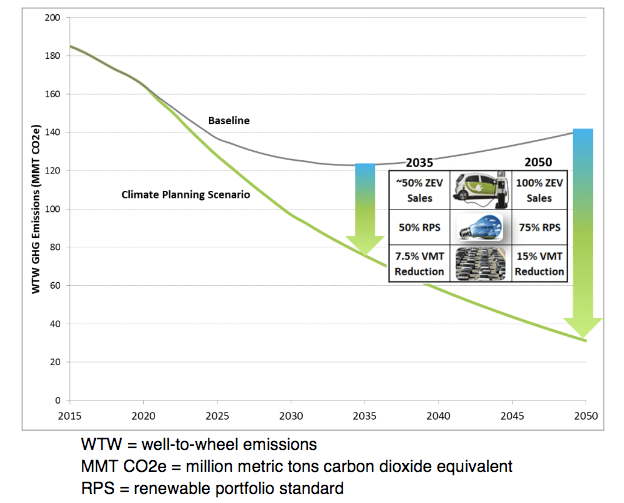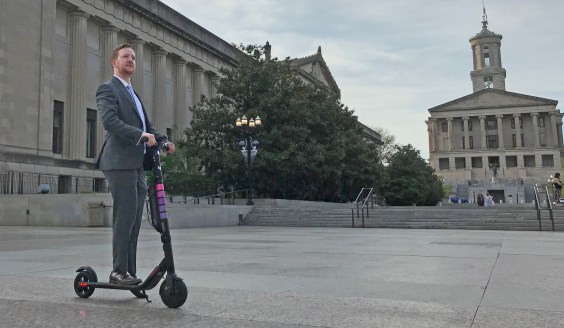The Air Resources Board (ARB) just released its proposed update to the S.B. 375 targets, which tell each region how much of the state's GHG reductions they are responsible for. California has set a high bar for GHG reductions statewide: last year's S.B. 32 set the statewide targets at forty percent below 1990 levels by 2030. Each region is responsible for coming up with strategies for reaching its targets.
The proposed targets will be presented and discussed at three upcoming workshops—in Bakersfield tomorrow, in L.A. on Wednesday, and in San Francisco next Wednesday, June 29. Details can be found here.
Some means of reducing emissions, like encouraging clean fuels, are state responsibilities, but each region, under the guidance of its Metropolitan Planning Organization (MPO), is responsible for a share of the state's total GHG reductions. Since transportation is the largest single contributor to GHG emissions in California, a large part of achieving reduction targets involves finding ways to make it easy for people to drive less.
The goal of S.B. 375 was to get regions to acknowledge that development patterns greatly affect transportation choices, and that planning for the two must be coordinated. But while the majority of MPOs control much of the available transportation funding, they have very little control over where housing and jobs are developed—local control has always been a strongly held tenet of land use planning.
This requires the MPOs to coordinate with local jurisdictions to develop plans that are consistent with both local and state goals. Some regions have approved their first set of strategies, called Sustainable Communities Strategies (SCS), and some regions are on their third update. ARB has determined that every region's strategies are enough to achieve its targets up to 2020.
But after 2020 the state climate goals will become much more stringent, and therefore harder to reach. This spring the ARB held a series of workshops to talk about new regional targets, and in keeping with its past practices, has allowed MPOs to have a large say in what their targets should be. MPOs did the analyses, compared alternative scenarios, and laid out challenges they faced.
At those workshops —and in their own target recommendations—the MPOs shared a number of reasons why they believe “reasonable” targets should be set. Regions shared two major obstacles preventing them from achieving higher targets: lack of funding and increases in driving due to factors beyond their control. At the same time, advocates pointed out that setting low, easy-to-reach targets would be a meaningless exercise, and do little to move the state towards its climate goals.
The MPOs have said that they are stymied by what they call the “rebound effect.” That is, they say that as driving becomes less expensive because vehicles are more fuel efficient—a good outcome of state efforts—people will drive more. The MPOs also say that they don't have enough money to invest in sustainable transportation options that would help reach the targets, and that what funding they do have is limited to certain types of expenses. That prevents them from being creative about investing them in ways that would most effectively help reduce GHGs, like maintaining and expanding transit or increasing walking and bicycling infrastructure.
To come up with the proposed targets, ARB conducted a thorough analysis. Their proposed targets are a little higher than what the MPOs asked for, but not as high as some advocates have recommended. Currently adopted S.B. 375 plans, added together, should achieve a seventeen percent reduction in statewide per capita GHG emissions relative to 2005 by 2035, according to the ARB proposal. But “the full reduction needed to meet our climate goals is on the order of a 25 percent reduction in statewide per capita GHG emissions by 2035.”
The report says that its proposed targets “would result in an additional reduction of greenhouse gas emissions of over ten million metric tons of CO2 per year in 2035 compared to the current targets.”
But this chart from the ARB's report shows how far that is from reaching overall targets.

“The previous targets were too low to meet the state's goals to reduce climate-changing pollution,” wrote ClimatePlan in a statement. While the proposed targets are lower than what ClimatePlan had recommended, they are, they wrote, “a step in the right direction.”
ClimatePlan is a network of organizations pushing for stronger targets. The process of target-setting lays the groundwork for many other tasks, including allocating funding, so it's important to get it right from the beginning. “With ambitious targets, the state can do more, not just for the climate, but for Californians' everyday lives,” wrote ClimatePlan.
Climate Plan has done extensive research on the results of S.B. 375—some of the only research that has been done on whether all this planning work has had its desired effect. In general, they found that results have been generally weaker than they could be, and that the lack of data makes it very difficult to measure and understand the cumulative effect of these efforts.
That's because it is all connected. For example, although MPOs are right when they say they have limited funding, they are about to get a lot of money from S.B. 1—and the question is, will they spend it in a way that furthers GHG reduction goals, or will they continue to focus on making driving easier and faster?
“The same strategies that will be needed to meet strong [GHG reduction] targets also address other critical state challenges and help meet the needs of Californians today,” wrote ClimatePlan. “Higher targets encourage regions to invest in existing communities, create more affordable homes, fund public transit, and conserve natural areas and farmland. These actions together reduce climate pollution -- while also making the air safer to breathe and saving families money.”
Before the proposed targets were released, ClimatePlan submitted a detailed letter to the ARB, pointing out areas where there is room for improvement that the MPOs might not be taking advantage of. For example, some of the alternatives analyses they performed didn't seriously consider large investments in public transit or active transportation, or the transformative potential of those kinds of projects. Nor did they consider the potential of shifting funding from highways to other forms of transportation.
In its letter, Climate Plan also noted that there is no time to waste. Climate change is already happening, and there should be urgency about putting a brake on business as usual. But too many of the MPOs are still focused on concerns about congestion, and still believe that they can solve it by widening roads, instead of looking at real alternatives that can meet a whole range of goals as well as reduce greenhouse gas emissions.






